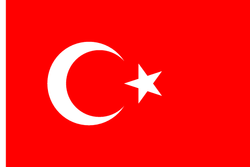Ottoman Flag
|
|

The flag of the Ottoman Empire (and later that of Turkey) is called Ay Yıldız which means moon star. The flag has an ancient and complex origin. The color red is a prominent color in Turkish history. The crescent and star, while being Islamic symbols have long been used by the Turks even before the advent of Islam. There are many references to the Ottoman Flag originally being simply a crescent on a green field, and this being changed in 1793 when Sultan Selim III officially changed the background to red, however this assumes there was merely a single flag for the Ottoman Empire. Until 1844 this was simply not true. Simultaneously the Ottoman Empire had four different merchant flags (red for Moslems, red with a green horizontal stripe in the middle for Moslems who had made the Hajj, blue stripe for Greek Christians, black stripe for Albanians, yellow stripe for Jews), a separate land (vertical bicolour of red and green), and naval forces (white cresent on red, with different stars for ranks) flag, a flag for the empire (which changed from the single crescent to the triple-crescent on a green circle), a flag for the sultan (red with his tughra in white or gold, a flag for the caliphate (green with a gold crescent, later crescent and star) and literally dozens of additional flags for officers (often bearing the Zulfikar, customs officials, etc.).
The star upon the flag is a very late addition, and appeared first upon naval flags, only in 1844 making its way on to the state flag. Some say the star symbol dates back to the time of Constantine and it was considered a symbol of Mary in his time, but rather it was an important part of the Turkish folklore, just like the crescent. The design of the three crescents on a green disc remained the flag of the empire right up until 1844, and this can be considered the "state" flag of the Ottoman Empire. Later sources have the disc as an oval rather than a circle, and the three crescents side by side rather in a triangular formation.
There are several legends associated with the symbols of the flag. The two most popular include a reflection of the moon occulting a star, appearing in pools of blood after the battle of Kosovo in 1448, and another refers to a dream of Osman I in which a crescent and star appeared from his chest and expanded over the entire world. None of these legends are actually true however, as the crescent began as the pre-Christian symbol for Byzantium. Byzantium's patron deity, Diana, was represented iconographically with a crescent moon. This was a convenient symbol for the Ottomans to adopt as it was very similar to the tamgha of the house of Osman, a stylized bow. Thus the Ottomans were able to technically "simplify" their Tamgha while simultaneously co-opting an ancient Greek symbol of Constantinople, to further the legitimacy of their rule over the city. Previously to the conquest of Constantinople crescent-shaped objects do proliferate through Ottoman iconography, though they all included stylized arrows. This is because a bow with an arrow or two arrows is the tamgha of the Kayi branch of the Oghuz Turks, the tribe from which Osman is descended.
The standard Ottoman naval flag was similar to the national flag but had a seven-pointed star. There was also a system of rank insignia where the flag determined the rank of the highest officer onboard. A flag with an anchor surrounded by four exploding bombs (sometimes with a cresent below the anchor) indicated that the Commander-in-Chief of the Ottoman naval forces (i.e. the sultan himself) was onboard. An anchor with no bombs was a commander of a naval base and such a flag with a swallowtail was a Junior Commander at sea. Five bombs were the Admiral of the Fleet and one the Rear Admirals. There were also swallow-tailed bomb flags, where three bombs were the Commodore and one the Commander.
The imperial banners displayed the sultan's tughra, often on a pink or bright red background. The religious colour of Islam is green, and many Ottoman flags were dark green. Sometimes it was just a plain green flag, sometimes the moon and star were painted in white and sometimes in yellow. Many royal banners picture the legendary Zulfikar sword. As of 1862 the flag of the sultan was green with seven thin, red, horizontal lines.
The flagpoles were often decorated by a cresent, a wolf head, a horse tail or a Qur'an box. In addition, banners were always accompanied by a number of smaller flags, pennants, icons and various other items with symbolic meaning (for example, the Janissaries used to parade with their cauldrons).
Ottoman1375.png
Ottoman1453.png
Ottoman1517.png
OttomanReligious.png
External link
- Flags of the World: Ottoman Empire (http://www.crwflags.com/fotw/flags/tr-ottom.html)

